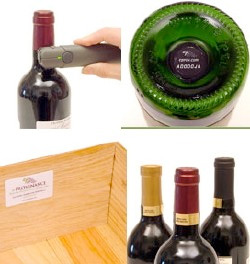
Luxist reports on a new service to help track the provenance of wine. When Tod and I were at NextFest we spoke to some folks at Hitachi who had contemplated using their RFID technology to do the same thing, but just recently two new services have come online that are designed to track wine by the bottle (the other is Great Wall of Wine, a Chinese merchant, who are using RFIDs to stop counterfeit wine).
This seems to be an unnecessarily narrow use of the technology. Counterfeit wine is a problem, but (in my understanding) it's primarily it's a problem with a few very old, very expensive bottles. Old wine is not going to have RFID stickers on it, and if one is applied in such a was as to not damage the expensive bottle, it'll probably be easily moved to another bottle. Moreover, the business plan (as I understand it) is dependent on Metcalfe's Law network effects to work. In other words, it becomes useful if lots of wine has the stickers (the old "if only you have a fax machine, then faxing isn't a useful technology" argument), but initially very little wine is going to have stickers on it. For systems like that to be successful, the technology needs to be useful to just a single user. That's exactly the situation where a rich information shadow becomes valuable, and if you excuse the self-promotion, that's why we made WineM focused on the richness of wine's information shadow rather than just a single application. But maybe I'm misunderstanding the business model. Maybe the people who really need these systems are not end consumers, but dealers, distributors and regulators. Regardless, between these projects, Smartcorq and the Queen's ISETAN experiment, it looks like wine and RFID are going to be mated at some point in the very near future. The question is whether the power of all of the information about the wine will be exposed to end users (to everyone's great benefit, in my opinion) or whether the technology will remain stuck in the realms of logistics and security.



